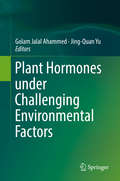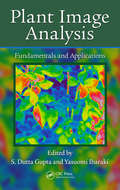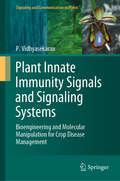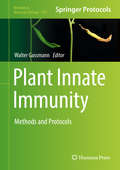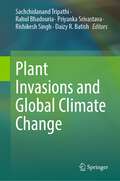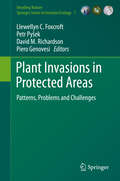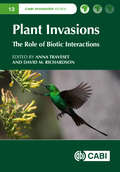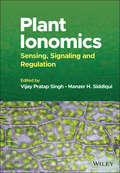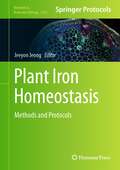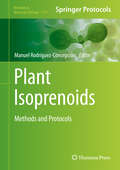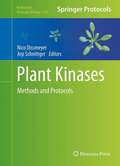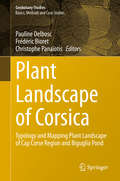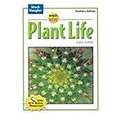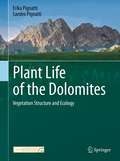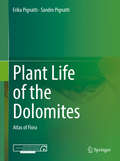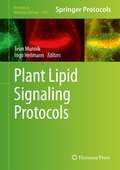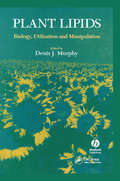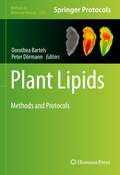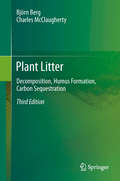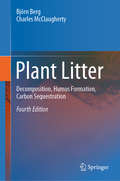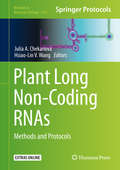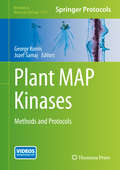- Table View
- List View
Plant Hormones under Challenging Environmental Factors
by Golam Jalal Ahammed Jing-Quan YuThis book presents recent advances in understanding the physiological and molecular mechanisms of different abiotic stresses such as high or low temperature, salinity, drought, flooding, soil acidity, heavy metals, light stress and ozone stress, and discusses the multifaceted role of phytohormones in stress adaptation and the underlying mechanisms. Aimed at students and researchers in the field of plant science, it offers a comprehensive overview of the versatile roles and interactions of different phytohormones in response to a specific stress factor and examines the possible physiological and molecular mechanisms that have been the subject of recent research.
Plant Image Analysis: Fundamentals and Applications
by S. Dutta Gupta Yasuomi IbarakiThe application of imaging techniques in plant and agricultural sciences had previously been confined to images obtained through remote sensing techniques. Technological advancements now allow image analysis for the nondestructive and objective evaluation of biological objects. This has opened a new window in the field of plant science. Plant Image
Plant Immunity
by John M. McdowellA great deal of effort is being invested in understanding the molecular mechanisms through which plants interact with pathogenic microbes. In Plant Immunity: Methods and Protocols, expert researchers in the field describe emerging technologies that can be applied to the most significant outstanding questions faced by scientists studying immunity in plants. The technologies in this detailed volume include methods for examining protein localization, protein complex purification, protein-protein interactions, transient and inducible gene expression, chromatin immunoprecipitation, microaspiration, laser microdissection, purification of fungal haustoria, and genetic manipulation of bacterial and oomycete pathogens. These techniques are applicable to a wide range of topics, including molecular functionality of NB-LRR proteins and other immune signaling components, and functional characterization of effector proteins and other pathogen components that sabotage host immunity. Written in the highly successful Methods in Molecular BiologyTM series format, chapters include introductions to their respective topics, lists of the necessary materials and reagents, step-by-step, readily reproducible laboratory protocols, and key tips on troubleshooting and avoiding known pitfalls.
Plant Innate Immunity Signals and Signaling Systems: Bioengineering and Molecular Manipulation for Crop Disease Management (Signaling and Communication in Plants #0)
by P. VidhyasekaranThe volume III of the book presents the ways and means to manipulate the signals and signaling system to enhance the expression of plant innate immunity for crop disease management. It also describes bioengineering approaches to develop transgenic plants expressing enhanced disease resistance using plant immunity signaling genes. It also discusses recent commercial development of biotechnological products to manipulate plant innate immunity for crop disease management. Engineering durable nonspecific resistance to phytopathogens is one of the ultimate goals of plant breeding. However, most of the attempts to reach this goal fail as a result of rapid changes in pathogen populations and the sheer diversity of pathogen infection mechanisms. Recently several bioengineering and molecular manipulation technologies have been developed to activate the ‘sleeping’ plant innate immune system, which has potential to detect and suppress the development of a wide range of plant pathogens in economically important crop plants. Enhancing disease resistance through altered regulation of plant immunity signaling systems would be durable and publicly acceptable. Strategies for activation and improvement of plant immunity aim at enhancing host’s capability of recognizing invading pathogens, boosting the executive arsenal of plant immunity, and interfering with virulence strategies employed by microbial pathogens. Major advances in our understanding of the molecular basis of plant immunity and of microbial infection strategies have opened new ways for engineering durable resistance in crop plants.
Plant Innate Immunity: Methods and Protocols (Methods in Molecular Biology #1991)
by Walter GassmannThe volume presents valuable methods that look at important biological processes not traditionally assayed in the study of plant immunity, and at non-model systems. The chapters in this book cover topics such as identifying host targets of acetylating effectors by immunoprecipitation; quantifying ATP release from plant cells; protein-DNA interactions; DNA methylation; measurement and playback of leaf vibrations; natural infection routes of Xanthomonas campestris pv. campestris using Arabidopsis; and isolating favorable plant-growth-promoting bacteria from the phytosphere. Written in the highly successful Methods in Molecular Biology series format, chapters include introductions to their respective topics, lists of the necessary materials and reagents, step-by-step, readily reproducible laboratory protocols, and tips on troubleshooting and avoiding known pitfalls.Cutting-edge and thorough, Plant Innate Immunity: Methods and Protocols is an essential resource for all researchers interested in expanding their knowledge and learning new techniques in this ever-growing field.
Plant Invasions and Global Climate Change
by Priyanka Srivastava Rishikesh Singh Rahul Bhadouria Sachchidanand Tripathi Daizy R. BatishThis edited book provides an ensemble of contemporary research related to the challenges, impacts and precautionary measures for tackling plant invasions in the context of changing climate in different regions of the world. In current scenario, plant invasions are expansive and significant component of anthropogenic global climate change. Temperature variations may compromise the adaptability of native species, thereby stressing them and decreasing the resistance potential of natural communities to invasion. Invasive alien species under the current scenario have been suggested as a major threat to biodiversity. It is also predicted that increasing disturbances or extreme events such as fires, floods, cyclones, storms, heat-waves, droughts, etc. will be direct consequences of changing climate supporting the invasive alien species. A comprehensive understanding of the interaction between species invasion and climate change will be supplemental in forecasting future shifts in biodiversity. Further, different predictive models indicate a plausible increase in the abundance and impact of invasive alien species which may have direct implications for future research and target-oriented policy and decision making. However, these predictions become more complicated considering the complexity of interactions between the impacts of changing climate with other components of global change (changes in land use, nitrogen deposition, etc.) which are affecting the distribution of native plant species, ecosystem dynamics as well as non-native/invasive species. This book will be suitable for students (undergraduate and postgraduates) of agriculture, forestry, ecology, soil science, and environmental sciences; teachers, researchers, and climate change scientists in academic and research institutions. It will also be applicable to environmental management agencies, government agencies and policy makers.
Plant Invasions in Protected Areas
by David M. Richardson Llewellyn C. Foxcroft Petr Pyšek Piero GenovesiThis book is the first comprehensive global review of all aspects of alien plant invasions in protected areas. It provides insights into advances in invasion ecology emanating from work in protected areas, and the link to locally relevant management support for protected areas. The book provides in-depth case studies, illuminating interesting and insightful knowledge that can be shared across the global protected area network. The book includes the collective understanding of 80 ecologists and managers to extract as much information as possible that will support the long-term management of protected areas, and the biodiversity and associated ecosystem services they maintain. "This outstanding volume draws together pretty much all that can be said on this topic, ranging from the science, through policy, to practical action". Dr. Simon N. Stuart, IUCN Species Survival Commission, UK. "This important and timely volume addresses two of the most serious problems affecting biodiversity conservation today: assessing the extent to which protected areas are impacted by biological invasions and the complex problems of managing these impacts. Written by leading specialists, it provides a comprehensive overview of the issues and gives detailed examples drawn from protected areas across the world". Professor Vernon H. Heywood, School of Biological Sciences, University of Reading, UK
Plant Invasions: The Role of Biotic Interactions (CABI Invasives Series)
by Robert D. Holt Cang Hui Pietro Landi Ashish Adhikari Marcelo A. Aizen Warwick J. Allen Christophe Baltzinger Iain R. Caldwell Regan M. Callaway Jane A. Catford Lohengrin A Cavieres Keith Clay Julie A Coetzee Robert I Colautti Carla M. D’Antonio John L. Devaney M. Celeste Díaz Vélez Professor Colleen T Downs Carine Emer Fernando Fernanda Ribeiro da Silva Ana E. Ferreras S. Luke Flory Erica M. Goss Philip F. Harmon Ruben H Heleno Martin P. Hill Richard Honor Christopher N. Kaiser-Bunbury Amy E Kendig Peter M Kotanen Sara E. Kuebbing Guillaume Latombe Brett R. Lane Johannes J. Roux Nathan P Lemoine Jacob. E. Lucero Ana Montero-Castaño Lindelwa S. Msweli Valeria Paiaro John D. Parker Marco Aurélio Pizo Evan M Rehm David M Richardson Ushma Shukla Benno I Simmons Lauren M. Smith-Ramesh Sérgio Timóteo Elizabeth M Wandrag Christopher M Wojan Stephanie G. YelenikThere are many books on aspects of plant invasions, but none that focus on the key role of species interactions in mediating invasions. This book reviews exciting new findings and explores how new methods and tools are shedding new light on crucial processes in plant invasions. In 23 chapters, with contributions from 51 authors, the book addresses: · the main theories and hypotheses in plant invasion ecology that invoke species interactions; · plant invasions that are facilitated by, or benefit from, by mutualistic interactions and release from enemies; · antagonistic interactions that prevent or hinder plant invasions; · impacts of plant invasions on native species interactions and ecosystem functioning; · the interaction-network approach to understanding plant invasions; · the importance of considering species interactions in managing plant invasions
Plant Ionomics: Sensing, Signaling and Regulation
by Manzer H. Siddiqui Vijay Pratap SinghPlant Ionomics A thoroughly up-to-date exploration of nutrient uptake in plants In Plant Ionomics: Sensing, Signaling and Regulation, accomplished botanists and researchers Dr. Vijay Singh and Dr. Manzer Siddiqui deliver an up-to-date discussion on the sensing, signaling, and regulation of nutrient uptake in plants under a variety of conditions. The book offers an accessible and easy-to-use reference for researchers with an interest in plant ionomics, combining the latest research from leading laboratories around the globe. The authors provide coverage of a variety of critical topics, including plant and soil nutrient stoichiometry, nutrient management and stress tolerance in crops, and the relationship between agricultural production and nutrient applications. Readers will also find: A thorough introduction to nutrient regulation and abiotic stress tolerance in plants In-depth discussions of nutrient uptake and transport in plants and the role of nutrients in ROS metabolism Practical explorations of nutrient and sugar signaling and associated gene networks in plants Extensive treatments of the role of nutrients in plant–microbe interactions and nutrient-use efficiency in plants Perfect for students, researchers, academics, and scientists with an interest in plant nutrition, Plant Ionomics: Sensing, Signaling and Regulation will also earn a place in the libraries of professionals in the agriculture and pharmaceutical industries.
Plant Iron Homeostasis: Methods and Protocols (Methods in Molecular Biology #2665)
by Jeeyon JeongThis detailed volume focuses on iron homeostasis in plants, iron being an essential micronutrient that serves as a cofactor in numerous metabolic processes but is harmful in excess. Specifically, the content ranges from protocols to study the iron deficiency response, the interaction between root and microbes under iron deficient conditions, the transcriptional network of iron homeostasis, systemic signaling of iron, chloroplast iron regulation, as well as methods on quantitative proteomics, histochemical iron staining, metal imaging using x-ray fluorescence microscopy, and more. Written for the highly successful Methods in Molecular Biology series, chapters include introductions to their respective topics, lists of the necessary materials and reagents, step-by-step and readily reproducible laboratory protocols, and tips on troubleshooting and avoiding known pitfalls. Authoritative and practical, Plant Iron Homeostasis: Methods and Protocols serves as a valuable resource for the plant iron homeostasis research community and will be of broad interest to plant biologists, soil scientists, and molecular biologists.
Plant Isoprenoids: Methods and Protocols (Methods in Molecular Biology #1153)
by Manuel Rodríguez-ConcepciónPlant Isoprenoids: Methods and Protocols is a collection of detailed techniques that will be a useful tool for a wide range of plant biologists, as well as for scientists of other fields interested in plant isoprenoids. Isoprenoids are an incredibly diverse family and they participate in a large variety of processes. Divided into four convenient sections to better cover strategic areas in plant isoprenoid research, topics include measurement of core enzyme activities involved in the production of isoprenoid precursors, targeted analysis of major groups of isoprenoid metabolites, isoprenoid profiling in specialized organs such as trichomes and oil glands as well as genetic, pharmacological and bioinformatic tools that are particularly useful for plant molecular biologists. Written in the successful Methods in Molecular Biology series format, chapters include introductions to their respective topics, lists of the necessary materials and reagents, step-by-step, readily reproducible protocols and notes on troubleshooting and avoiding known pitfalls.Authoritative and easily accessible, Plant Isoprenoids: Methods and Protocols will serve as an excellent reference material that can be adapted to develop customized methods for different needs making the world of plant isoprenoids more accessible for all researchers.
Plant Kinases: Methods and Protocols (Methods in Molecular Biology #779)
by Arp Schnittger Nico DissmeyerModification of target protein properties by reversible phosphorylation events has been found to be one of the most prominent cellular control processes in all organisms. Recent advances in the areas of molecular biology and biochemistry are presenting new possibilities for reaching an unprecedented depth and a proteome-wide understanding of phosphorylation processes in plants as well as in other species. The major goal of Plant Kinases: Methods and Protocols is to provide the experimentalist with a detailed account of the practical steps necessary for successfully carrying out each protocol in his or her own laboratory. Plant protein kinases specifically addressed in this volume are members of the plant MAP kinase cascade, cyclin- and Calcium-dependent protein kinases, and plant sensor and receptor kinases. Written in the highly successful Methods in Molecular BiologyTM series format, chapters contain introductions to their respective topics, lists of the necessary materials and reagents, step-by-step, readily reproducible laboratory protocols, and notes on troubleshooting and avoiding known pitfalls. Authoritative and accessible, Plant Kinases: Methods and Protocols will prove a useful laboratory companion to both novice and seasoned researchers by facilitating the practical work that will lead them to new and exciting insights in this dynamic field.
Plant Landscape of Corsica: Typology and Mapping Plant Landscape of Cap Corse Region and Biguglia Pond (Geobotany Studies)
by Pauline Delbosc Frédéric Bioret Christophe PanaïotisSince the 1970s and particularly the works of Tüxen (1978) and Géhu & Rivas-Martínez (1981), dynamico-catenal phytosociology has facilitated the integration of vegetation dynamics by more precisely describing the trajectories of vegetation series. A national habitat mapping program (CarHAB), launched by France’s Ministry of Ecology, aims to map the vegetation and vegetation series of metropolitan France at a scale of 1: 25,000 by 2025. In this context, Corsica has been selected as a pilot region, due to its unique characteristics regarding Mediterranean and alticole vegetation. This book describes in detail the vegetation series and geoseries (ecology, structure, dynamic trajectories, effects of anthropogenic factors on vegetation dynamics, catenal positioning in the landscape) of two Corsican sectors: Cap Corse and Biguglia pond. These two study sites were selected using two methods: • For Cap Corse, the typology and mapping are based on an inductive approach, which seeks to understand the dynamics of vegetation by drawing on the mature, substitutional, pioneering and anthropogenic associations likely to exist within a tessellar envelope. These various dynamic stages characterize “the vegetation series” (sigmetum or synassociation), the fundamental unit of symphytosociology (Géhu 2006; Biondi 2011). The aim of symphytosociology is, therefore, to define the vegetation series; in other words, it seeks to identify the repetitive combinations of syntaxa under homogeneous ecological conditions. • For Biguglia pond, the typology and mapping are based on a deductive approach, which combines (under SIG) the ecological descriptor maps with the vegetation mapping, in order to reveal the tesselas and the natural potential vegetation that underlies them. Thanks to the improvement of GIS techniques, this approach has been frequently used to characterize plant landscapes from vegetation to vegetation geoseries since the 2000s, with applications to the conservation management of natural and semi-natural environments.
Plant Life of the Dolomites
by Erika Pignatti Sandro PignattiThis volume provides an in-depth analysis of over 100 plant communities of the Dolomite vegetation. The data is based on the phytosociological relevés, which have been collected by the authors in nearly 2000 surveys. The key part consists of approx. 130 association tables presenting plant sociological data for the respective plant communities. Thus, this volume perfectly complements the successful main volume "Plant Life of the Dolomites: Vegetation Structure and Ecology," which features summarized, synoptic association tables of the twelve habitats. In addition, geo-referenced locations of relevés and detailed ecological measures are provided. A further part describes the individual components of the fascinating dolomitic landscape (Heritage of all Humanity) and presents tables of vegetation complexes, which summarize the more than 400 surveys carried out in the Dolomites. The structure of this supplementary volume corresponds to that of the main volume with a key part consisting of twelve chapters, each describing a specific habitat, and a total of 106 associations. Several topics covered in the main volume, such as the exploration of the flora, ecological factors and syntaxonomy are discussed further here.
Plant Life of the Dolomites
by Erika Pignatti Sandro PignattiThis volume offers distribution maps of over 2200 individual species living in the Dolomite area, presenting detailed records on the local range of every species growing in the area studied, from the Puster Valley to the Piave River. The data was collected on the basis of a multiple field observations carried out over several decades. After dividing the area into approx. 200 quadrants, a nearly complete census of the species present was obtained for each quadrant. The evaluation and synopsis of this extensive set of data, which is presented in the form of a chorological atlas in keeping with international standard methods, allows the area to be accurately compared with other parts of the Alps. In addition to the chorological atlas and floristic inventory, a list of synonyms and toponyms of the three languages used in the analyzed territory, an expanded list of updated scientific names, and some helpful remarks on various Dolomites species are included. Lastly, the book explores how species can be considered as landscape bioindicators. This third volume of the work Plant Life of the Dolomites complements the main volume Vegetation Structure and Ecology and the volume Vegetation Tables, which presents essential data at the plant association level.
Plant Life: The Entangled Politics of Afforestation
by Rosetta S. ElkinHow afforestation reveals the often-concealed politics between humans and plantsIn Plant Life, Rosetta S. Elkin explores the procedures of afforestation, the large-scale planting of trees in otherwise treeless environments, including grasslands, prairies, and drylands. Elkin reveals that planting a tree can either be one of the ultimate offerings to thriving on this planet, or one of the most extreme perversions of human agency over it. Using three supracontinental case studies—scientific forestry in the American prairies, colonial control in Africa&’s Sahelian grasslands, and Chinese efforts to control and administer territory—Elkin explores the political implications of plant life as a tool of environmentalism. By exposing the human tendency to fix or solve environmental matters by exploiting other organisms, this work exposes the relationship between human and plant life, revealing that afforestation is not an ecological act: rather, it is deliberately political and distressingly social. Plant Life ultimately reveals that afforestation cannot offset deforestation, an important distinction that sheds light on current environmental trends that suggest we can plant our way out of climate change. By radicalizing what conservation protects and by framing plants in their total aliveness, Elkin shows that there are many kinds of life—not just our own—to consider when advancing environmental policy.
Plant Lipid Signaling Protocols: Methods And Protocols (Methods in Molecular Biology #1009)
by Teun Munnik Ingo HeilmannAs scientist begin to understand the complexity of lipid signaling and its roles in plant biology, there is an increasing interest in their analysis. Due to the low abundancy and transient nature of some of these hydrophobic compounds, this is not always easy. In Plant Lipid Signaling Protocols, expert researchers in the field detail experimental approaches by which plant signaling lipids can be studied. These methods and techniques include analysis of plant signaling lipids, including detailed protocols to detect various relevant compounds by targeted or non-targeted approaches; to assay relevant enzyme activities in biological material or using recombinant enzymes; to test for specific binding of signaling lipids to protein partners; or to visualize signaling lipids or lipid-derived signals in living plant cells. Written in the highly successful Methods in Molecular Biology series format, chapters include introductions to their respective topics, lists of the necessary materials and reagents, step-by-step, readily reproducible laboratory protocols, and key tips on troubleshooting and avoiding known pitfalls. Authoritative and practical, Plant Lipid Signaling Protocols aids plant researchers in the continuing to study the roles of lipid signals.
Plant Lipids: Biology, Utilisation and Manipulation (Biological Sciences Ser.)
by Denis J. MurphyNew research tools have revealed many surprising aspects of the dynamic nature of lipids and their participation in processes such as recognition, intra- and inter-cellular signalling, deterrence and defense against pathogens, membrane trafficking and protein function. This is in addition to new information on the more established roles of plant lipids as structural components of membranes and as long-term storage products. Plant lipids are also increasingly being seen as sources of a new generation of environmentally friendly, biodegradable, and renewable industrial products, including biopolymers and high-grade lubricants.Plant Lipids: Biology, Utilisation and Manipulation provides a broad overview of plant lipid research and its many applications. Linking various disciplines, the editor brings together researchers from major international laboratories to review the history and current state of progress in this quickly evolving field. The text starts by providing a fascinating historical perspective on the study of plant lipids, from its inception as a branch of alchemy in the seventeenth century to the current post-genomic era. It then offers a detailed discussion on the formation, modification and utilization of fatty acids. This is followed by an exploration of the major classes of macromolecular structures formed by plant lipids, including bilayer membranes and storage bodies. From there, the contributors consider other types of macromolecular lipid assemblies in plants, examining proteins and the key plant lipid structure - the cuticle. The final chapters look at diverse classes of plant lipids that are linked to various aspects of signaling. This text provides an excellent resource for researchers and professionals in plant biochemistry, molecular biology, biotechnology and genetics, in both the academic and industrial sectors. It also meets the needs of students looking for a comprehensive introduction to this field, as well as direction for fut
Plant Lipids: Methods and Protocols (Methods in Molecular Biology #2295)
by Dorothea Bartels Peter DörmannThis volume explores analytical methods to study complex lipid mixtures from plants and algae. The chapters in this book are organized into five parts and cover topics such as basic methods of lipid isolation and analysis; mass spectrometry and NMR analysis; lipid isolation and analysis from plant tissues, cell compartments and organelles; lipid signaling, lipid-protein interactions, and imaging; and lipid databases. Written in the highly successful Methods in Molecular Biology series format, chapters include introductions to their respective topics, lists of the necessary materials and reagents, step-by-step, readily reproducible laboratory protocols, and tips on troubleshooting and avoiding known pitfalls.Cutting-edge and comprehensive, Plant Lipids: Methods and Protocols is a valuable guide for experienced researchers and undergraduate, graduate, and Ph.D. students. This book is also an excellent resource for novice scientists with little to no experience in lipid experiments who are interested in approaching this field experimentally.
Plant Litter
by Björn Berg Charles McclaughertySince the publication of the 2nd edition, there have been substantial developments in the field of litter decomposition. This fully revised and updated 3rd edition of Plant Litter reflects and discusses new findings and re-evaluates earlier ones in light of recent research and with regard to current areas of investigation. The availability of several long-term studies allows a more in-depth approach to decomposition patterns and to the later stages of decomposition, as well as to humus formation and accumulation. The latest information focuses on three fields: - the effects of manganese on decomposition and possibly on carbon sequestration, - new findings on decomposition dynamics, and - the new analytical technique using 13C-NMR.
Plant Litter: Decomposition, Humus Formation, Carbon Sequestration
by Björn Berg Charles McClaughertyThis book gives basic facts about litter decomposition studies, which are of guidance for scientists who start studies. Since the publication of the third edition, there has been quite a development not only in the field of litter decomposition but also in supporting branches of science, which are important for fruitful work on and understanding of decomposition of plant litter and sequestration of carbon. A consequence is that ‘old established truths’ are becoming outdated. New knowledge in the fields of phytochemistry and microbial ecology has given a new baseline for discussing the concepts ‘litter decomposition’ and ‘carbon sequestration’. We can also see a rich literature on litter decomposition studies using roots and wood as substrates. These have given new insights in factors that regulate the decomposition rate and as regards roots their contribution to sequestered carbon in humus. Additional facts on the role of temperature vs the litters’ chemical composition may in part change our view on effects of climate change. Further information on applications of the new analytical technique (13C-NMR) for determining organic-chemical compounds has allowed us to develop these parts. Focus is laid on needle litter of Scots pine as a model substrate as this species has been considerably more studied than other litter species. Also the boreal/northern temperate coniferous forest has in part been given this role. Still, new information may allow us to develop information about litter from further tree species.
Plant Long Non-Coding RNAs: Methods and Protocols (Methods in Molecular Biology #1933)
by Julia A. Chekanova Hsiao-Lin V. WangThis volume focuses on various approaches to studying long non-coding RNAs (lncRNAs), including techniques for finding lncRNAs, localization, and observing their functions. The chapters in this book cover how to catalog lncRNAs in various plant species; determining subcellular localization; protein interactions; structures; and RNA modifications. Written in the highly successful Methods in Molecular Biology series format, chapters include introductions to their respective topics, lists of the necessary materials and reagents, step-by-step, readily reproducible laboratory protocols, and tips on troubleshooting and avoiding known pitfalls.Cutting-edge and innovative, Plant Long Non-Coding RNAs: Methods and Protocols is a valuable resource that aids researchers in understanding the functions of lncRNAs in different plant species, and helps them explore currently uncharted facets of plant biology.
Plant MAP Kinases
by George Komis Jozef ŠamajMitogen-activated protein kinases (MAPKs) are versatile phosphorylating enzymes which regulate multiple proteins involved in gene expression, cell architecture, plant development and reaction to diverse abiotic and biotic factors. The main aim of Plant MAP Kinases: Methods and Protocols is to provide established and new MAPK protocols adapted to the challenges posed by working with plants. The book contains 19 chapters which encompass a wide array of methods progressively scaling from the single gene, protein or cell level to large-scale arrays of proteomic, phosphoproteomic and interactomic data in order to uncover previously unidentified plant MAPK signaling pathways and to tackle with the challenging task of substrate identification. Techniques for MAPK sequence analysis and subcellular localization helping to identify their substrates and subcellular compartmentalization are also provided. Written in the highly successful Methods in Molecular Biology series format, chapters include introductions to their respective topics, lists of the necessary materials and reagents, step-by-step, readily reproducible laboratory protocols, and key tips on troubleshooting and avoiding known pitfalls. Authoritative and practical, Plant MAP Kinases: Methods and Protocols represents a collection of useful plant MAPK protocols written by experts in the field for researchers and students.
